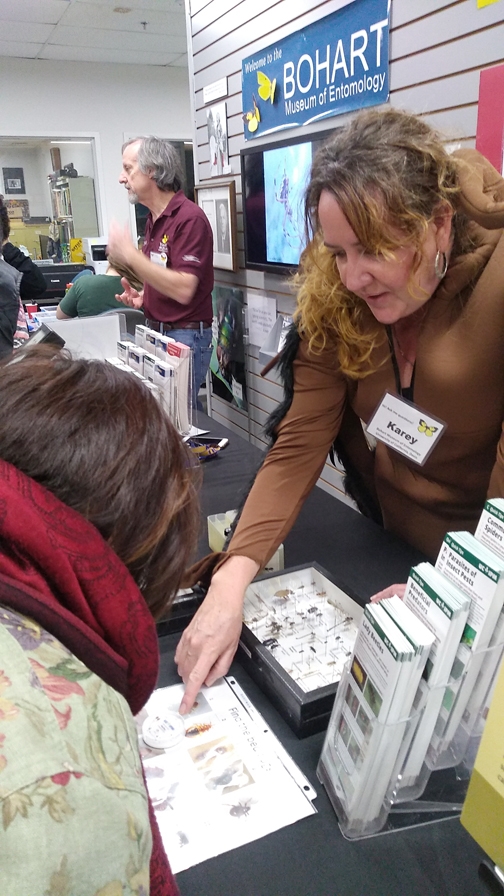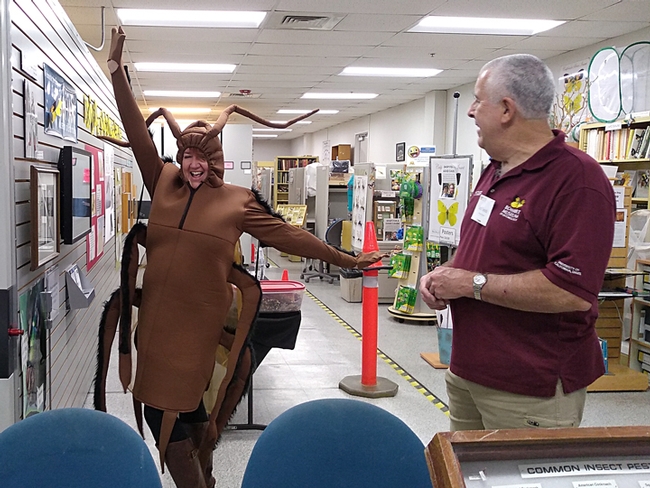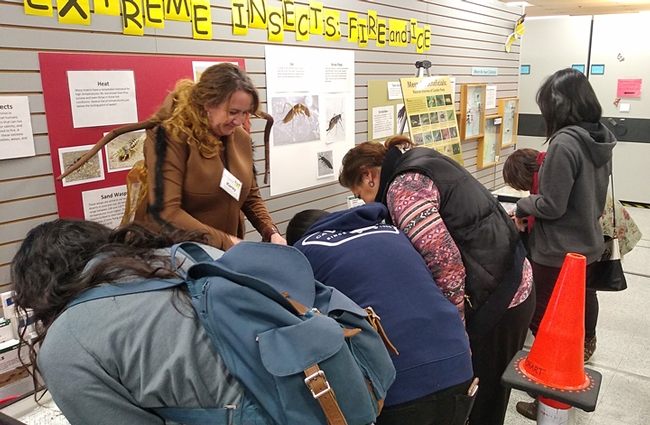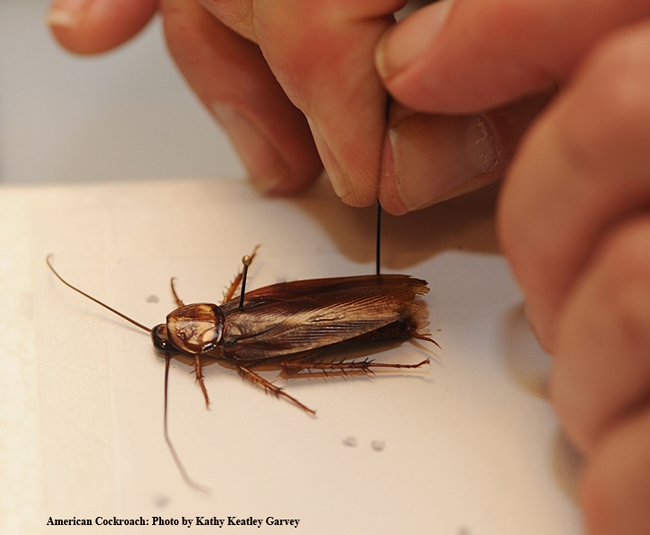
However, bed bugs, carpet beetles and pantry pests got into the act and competed mightily for the spotlight.
The occasion: The UC Davis Bohart Museum of Entomology open house, held Sunday afternoon, Nov. 18. The theme: "Urban Entomology."
The three-hour event starred a cockroach--well, a human dressed as a cockroach.
Karey Windbiel-Rojas of the UC Statewide Integrated Pest Management Program (UC IPM)--she's the associate director for Urban and Community IPM who serves as the area urban IPM advisor for Yolo, Sacramento and Solano counties--donned her cockroach costume and joined Bohart scientists in fielding questions about urban pests.
The pests the UC IPM scientist has been dealing with lately include carpet beetles, bed bugs and pantry pests. She handed out two newly published Quick Tips on carpet beetles and pantry pests, as well as information on other pests. What are some of the other pests? Check out UC IPM's Quick Tips library at http://ipm.ucanr.edu/QT/index.html.
UC IPM offers a wealth of information on its website, including
- home, garden, turf and landscape pests
- agricultural pests
- natural environment pests, and
- exotic and invasive pests
But when a cockroach is scurrying about (that was Karey's Halloween costume, by the way), the mind focuses on the "ins" and "outs" of cockroaches. Mostly the "outs."
As in: Stay. Out. Never. Ever. Come. Back. In.
"There are six species of cockroaches in California that can become pests: German cockroach, brownbanded cockroach, oriental cockroach, smokybrown cockroach, American cockroach, and Turkestan cockroach. A seventh species, the field cockroach, is not really a pest. It is usually found outdoors, but sometimes comes indoors when it is hot or dry and is often mistaken for the German cockroach. Of these seven species, the one that has the greatest potential for becoming persistent and troublesome is the German cockroach, which prefers indoor locations. Oriental and American cockroaches occasionally pose problems in moist, humid areas."--Excerpt from UC IPM Pest Note on Cockroaches.
As the UC IPM website indicates, cockroaches "may become pests in homes, schools, restaurants, hospitals, warehouses, offices, and virtually in any structure that has food preparation or storage areas. They contaminate food and eating utensils, destroy fabric and paper products, and impart stains and unpleasant odors to surfaces they contact."
Cockroaches can definitely give you a difficult time.
And speaking of giving, today (Tuesday) is Giving Tuesday, and UC IPM Director Jim Farrar has committed to eating a pest if at least 20 people make a donation of $10 or more to UC IPM.
UC Agriculture and Natural Resources (UC ANR) spokesperson Pamela Kan-Rice, assistant director of News and Information Outreach, informed us: "With your donation and Jim's appetite, there will be one less pest to deal with! Spread the word to colleagues, family and friends to help UC IPM meet this goal. All UC IPM donors will be invited to the special pest eating event which will take place in the afternoon on Wednesday, Nov 28 in the UC ANR building." The dining experience is expected to begin at 4 p.m.
Here's where to donate before midnight tonight: https://donate.ucanr.edu/pages/integrated-pest-management.
We asked Karey if the pest to be consumed could possibly be a cockroach. Or a garden-variety pest, such as a dandelion.
"To my knowledge he will not be eating a cockroach or a dandelion," she commented in an email. "I don't want to give away what he might be eating (so I don't actually know for sure)."
That would be a definite "no" on the roach!
(Update: Director Farrar ate corn smut, grasshoppers and live mealworms.)
Attached Images:

Karey Windbiel-Rojas' cockroach costume proved a crowd pleaser at the Bohart Museum of Entomology open house. Here entomologist Jeff Smith, who curates the butterflies and moths at the Bohart, gives his approval. Windbiel-Rojas, with the UC Statewide Integrated Pest Management Program (UC IPM) is the associate director for Urban and Community IPM. (Photo by Tabatha Yang)

Pests, including cockroaches, drew the rapt attention of this crowd at the Bohart Museum of Entomology. That's Karey Windbiel-Rojas fielding questions. (Photo by Tabatha Yang)

Senior museum scientist Steve Heydon pins an American cockroach. (Photo by Kathy Keatley Garvey)